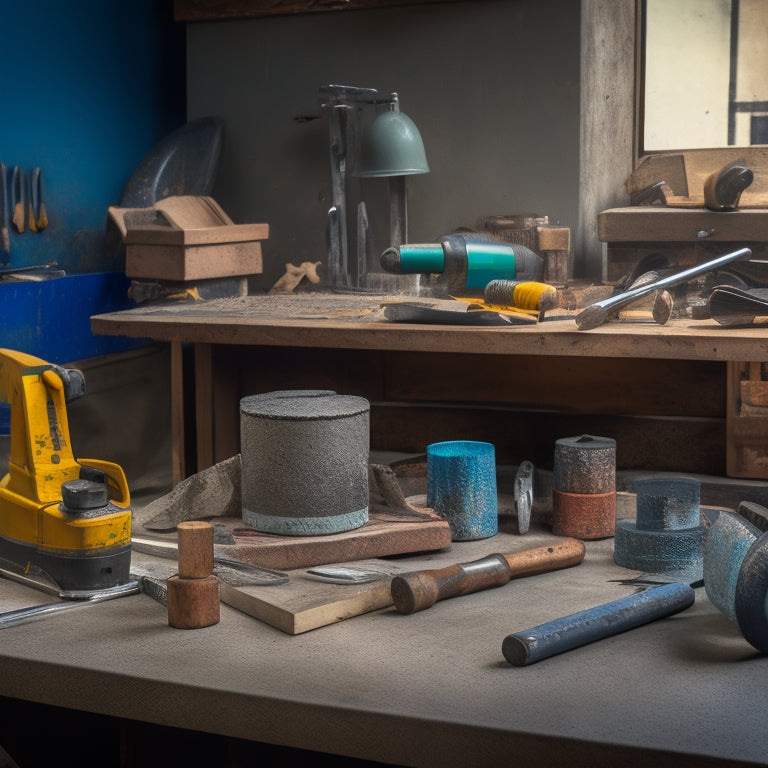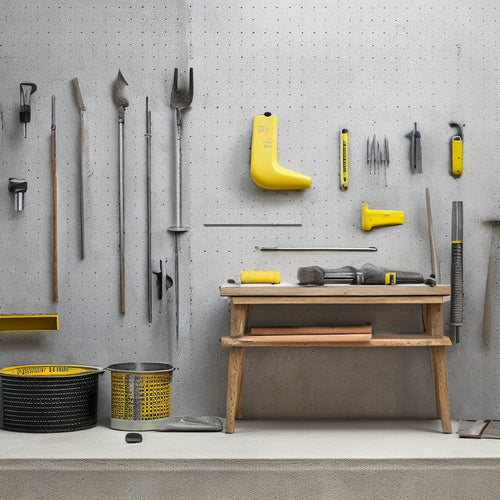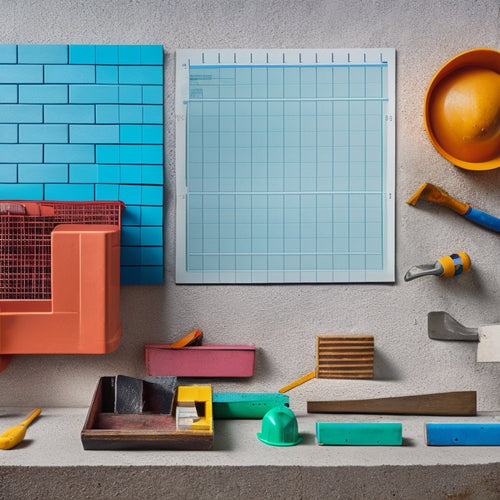
Top Hand Tools for Finishing Concrete Blocks
Share
When working with concrete blocks, you'll need a range of specialized hand tools to achieve a professional-looking finish. Start with trowels, which come in three types: pointing for small areas, finishing for smooth surfaces, and pool for larger areas. Edgers are important for clean corners and finishing edge control, while floats help level concrete and guarantee a smooth finish. Jointers are essential for filling cracks and joints, and rakes and scrapers aid in surface preparation. Additionally, tamping tools, precise angle cutting tools, and finishing techniques like swishing and pressure control are critical for a flawless finish. Mastering these tools and techniques will take your concrete block finishing skills to the next level.
Key Takeaways
• For smooth finishes, use trowels made of high-carbon steel or stainless steel with ergonomic handles to reduce fatigue.
• Edgers, such as corner, radius, and bevel edgers, help achieve clean corners and finishing edge control in concrete blocks.
• Floats, including bull and darby floats, are essential for leveling concrete and ensuring a smooth, even finish.
• Jointers are necessary for creating smooth, seamless connections in concrete blocks, with blade width selection depending on gap size.
• Rakes and scrapers are used for surface preparation, removing excess material and old adhesive for a smooth finish on concrete blocks.
Essential Trowels for Smooth Finishes
You'll need three essential trowels in your arsenal to achieve a smooth finish on concrete blocks: a pointing trowel, a pool trowel, and a finishing trowel, each designed for a specific stage of the finishing process.
The pointing trowel, typically 2-3 inches wide, is used for applying and smoothing small areas of concrete. Its small size allows for precise control and is ideal for filling gaps and joints.
The pool trowel, usually 4-6 inches wide, is used for applying and smoothing larger areas of concrete. Its larger size and curved blade make it perfect for spreading and leveling concrete.
The finishing trowel, typically 8-12 inches wide, is used for the final stage of finishing, providing a smooth, even finish.
When selecting trowels, consider the materials used, such as high-carbon steel or stainless steel, which provide durability and resistance to corrosion.
Additionally, choose trowels with ergonomic handles to reduce fatigue and improve control.
Edgers for Clean Corners
When working with edgers to achieve clean corners, you'll want to focus on maintaining precise control over the edge's position and angle.
This is essential, as even slight deviations can compromise the integrity of the corner.
Corner Edge Control
Corner Edge Control
To achieve precise, 90-degree corners and clean edges on concrete blocks, edgers are essential hand tools that help you control and refine the corner edges during the finishing process. By using edgers, you can perfect your corner finishing techniques and edge smoothing methods, ensuring a professional-looking finish.
Here's a comparison of popular edger types and their applications:
| Edger Type | Corner Angle | Edge Smoothing |
|---|---|---|
| Radius Edger | 90°, 45° | Medium-smooth edges |
| Bevel Edger | 45°, 22.5° | Smooth, chamfered edges |
| Corner Edger | 90°, 135° | Sharp, precise corners |
| Combination Edger | 90°, 45°, 22.5° | Versatile, smooth edges |
When choosing an edger, consider the type of corner edge control you need for your concrete block project. By selecting the right edger, you'll be able to achieve clean, precise corners and smooth edges that enhance the overall appearance of your finished concrete blocks.
Precise Angle Cutting
For precise angle cutting and clean corners, edgers with adjustable angle settings allow you to achieve exact 90-degree corners and precise bevels on concrete blocks. These edgers usually come with angle measurement tools, such as protractors or digital angle finders, which allow you to set the desired angle with precision. This guarantees that your cuts are accurate and consistent, resulting in professional-looking finishes.
When using edgers for precise angle cutting, it's crucial to employ precision cutting techniques. Start by setting the edger to the desired angle, then carefully align the blade with the concrete block's edge.
Apply gentle to moderate pressure, depending on the block's density, and slowly move the edger along the edge to achieve a clean, precise cut. To maintain control, keep the edger straight and level, and avoid applying too much pressure, which can cause the blade to wander.
Floats for Leveling Concrete
You'll typically reach for a float to level and smooth out freshly poured concrete, as this tool allows you to achieve a uniform surface with minimal effort.
There are two primary float types to take into account: bull floats and darby floats. Bull floats are larger and heavier, ideal for large, flat areas, while darby floats are smaller and more agile, perfect for smaller, more intricate spaces.
Regardless of the type, proper float maintenance is essential to achieve ideal results. Regularly clean your float to prevent concrete buildup, and store it in a dry place to prevent rust. You should also inspect your float's blade regularly, replacing it as needed to maintain its effectiveness.
When using your float, apply gentle to moderate pressure, depending on the concrete's consistency. Work in sections, overlapping your strokes to guarantee a smooth, even finish.
Remember to keep your float flat and level, as angled or tilted use can create uneven surfaces. By mastering the art of float work, you'll be able to achieve professional-looking results with ease, paving the way for a flawless concrete finish.
Finishing Trowels for Walls
After leveling and smoothing the concrete surface with a float, turn your attention to finishing trowels for walls, which play an essential role in achieving a uniform, high-quality finish on vertical surfaces.
You'll need to select the right trowel type for your specific project, as there are various options available. For instance, a pointing trowel is ideal for filling gaps and creating a smooth surface, while a finishing trowel with a curved or angled blade is better suited for applying and smoothing finish coats.
When it comes to finishing techniques, you'll need to master the art of holding and moving the trowel at the correct angle to achieve the desired finish. For a smooth, even finish, hold the trowel at a 45-degree angle and apply gentle to moderate pressure.
As you move the trowel in a circular motion, use a gentle 'swishing' action to spread the material evenly. By mastering these finishing techniques and selecting the right trowel type, you'll be able to achieve a professional-looking finish on your concrete block walls.
Hand Floats for Small Areas
Mastering the art of finishing concrete blocks requires precision tools, and when it comes to small areas, hand floats prove invaluable for achieving a smooth, even finish. You'll need to select the right hand float for the job, considering factors like float material, size, and weight.
| Float Material | Advantages | Disadvantages |
|---|---|---|
| Magnesium | Lightweight, easy to maneuver | May leave slight marks on surface |
| Aluminum | Durable, resistant to corrosion | Heavier, more difficult to handle |
| Resin | Soft, flexible, and gentle on surface | May absorb water, affecting performance |
| Stainless Steel | High-quality, long-lasting | Most expensive option |
| Wood | Traditional, eco-friendly | Prone to warping, requires maintenance |
When using hand floats, it is crucial to employ proper techniques to achieve the desired finish. Start by applying gentle pressure, gradually increasing as needed. Use long, sweeping motions to cover the entire area, working in sections to maintain evenness. Remember to keep your hand float clean and free of debris to prevent marring the surface. By selecting the right float material and mastering hand float techniques, you'll be able to achieve a professional-grade finish in even the smallest areas.
Jointers for Cracks and Joints
When finishing concrete blocks, jointers play an important role in creating smooth, seamless connections between cracks and joints. You'll use these tools to fill gaps and guarantee a watertight seal, which is vital for the structural integrity and appearance of the finished product. As you work on joint maintenance techniques, you'll find that jointers are essential for creating a strong bond between the concrete blocks.
When selecting a jointer, consider the type of joint you're working with. For example, if you're dealing with large gaps, you'll want a jointer with a wider blade. For smaller joints, a narrower blade will provide more precision. It's also important to choose a jointer that's designed for the specific joint sealing methods you're using. Some jointers are better suited for epoxy-based sealants, while others are designed for cement-based sealants.
As you work on filling joints and cracks, remember to apply even pressure and maintain a consistent speed to avoid creating air pockets or uneven surfaces.
With the right jointer and technique, you'll be able to achieve a professional-looking finish that will last for years to come.
Pointing Trowels for Details
You'll reach for a pointing trowel when it's time to add finer details to your concrete block project, such as filling small gaps and creating clean edges around windows and door openings. This versatile tool allows for precise control, enabling you to execute intricate pointing techniques with ease.
When selecting a pointing trowel, consider the trowel materials that will best suit your needs. Stainless steel or carbon steel blades provide durability and rust resistance, while fiberglass or wood handles offer a comfortable grip.
For best results, choose a trowel with a blade width that matches the size of the gaps you're filling. A narrower blade (around 1-2 inches) is ideal for small gaps and edges, while a wider blade (around 3-4 inches) is better suited for larger areas.
Remember to always hold the trowel at a 45-degree angle and use gentle, sweeping motions to avoid scratching the surrounding concrete. With practice and patience, you'll master the art of pointing and achieve professional-looking results that elevate your concrete block project to the next level.
Rakes for Removing Excess
When you're working with concrete blocks, you'll need to remove excess material to achieve a smooth finish.
You'll use rakes specifically designed for this task to control the finishing edge and eliminate excess concrete.
Excess Material Removal
Removing excess material from freshly poured concrete blocks is crucial to achieving a smooth, even finish, and rakes specifically designed for this task are indispensable to the process.
You'll need to develop effective excess material strategies to guarantee a professional-looking result. To start, choose a rake with sturdy, adjustable tines that can be set to the desired depth. This allows you to control the amount of material removed and prevent over-raking, which can lead to unevenness.
When using your rake, employ removal techniques that work in harmony with the concrete's consistency. For example, if the mix is particularly wet, use a more aggressive raking motion to remove excess material quickly. Conversely, if the mix is stiffer, use a more gentle, sweeping motion to avoid damaging the surface.
Remember to rake in a consistent pattern, working in sections to maintain evenness. By mastering these excess material removal techniques, you'll be well on your way to achieving a flawless, professional-grade finish.
Finishing Edge Control
Finishing Edge Control
Once you've removed excess material, focus on refining the edges with specialized rakes designed for finishing edge control, which enable precise manipulation of the concrete's perimeter. These rakes are specifically designed to help you achieve precise edge finishing techniques, giving you the desired decorative edge options for your concrete blocks.
| Rake Type | Edge Finish |
|---|---|
| Fine-tooth rake | Smooth, rounded edges |
| Coarse-tooth rake | Textured, rustic edges |
| Notched rake | Decorative, patterned edges |
When choosing a rake, consider the type of edge finish you want to achieve. Fine-tooth rakes are ideal for smooth, rounded edges, while coarse-tooth rakes produce textured, rustic edges. Notched rakes, on the other hand, allow for decorative, patterned edges. By selecting the right rake, you'll be able to achieve the desired edge finish, adding a professional touch to your concrete blocks. With these specialized rakes, you'll have complete control over the edge finishing process, ensuring a high-quality finish that meets your standards.
Scrapers for Removing Old Adhesive
You'll need a sturdy scraper to effectively dislodge old adhesive from concrete blocks, an essential step in preparing the surface for new finishes. The type of scraper you choose will depend on the adhesive type and the surface preparation required. For example, if you're dealing with a strong epoxy-based adhesive, you'll need a scraper with a robust blade to effectively break the bond. On the other hand, if you're working with a weaker acrylic-based adhesive, a scraper with a more flexible blade may be sufficient.
When selecting a scraper, look for one with a durable handle and a replaceable blade. This will guarantee that you can apply the necessary pressure without compromising the tool's integrity.
Additionally, consider the scraper's angle of attack, as this will impact its effectiveness in dislodging the adhesive. A scraper with an adjustable angle will provide more versatility and control.
Tamping Tools for Compacting
When compacting concrete blocks, you'll want to use tamping tools to achieve even compaction patterns and prevent air pockets from forming.
To do this, you'll need to apply consistent pressure in a controlled manner, ensuring that the tool's striking surface is in full contact with the block's surface.
Even Compaction Patterns
Achieving even compaction patterns with tamping tools is essential to preventing uneven settlement and guaranteeing the structural integrity of concrete block structures.
You'll want to master various compaction techniques to guarantee surface uniformity. Start by dividing the concrete block surface into sections, and then use your tamping tool to compact each section in a consistent, overlapping pattern. Apply gentle to moderate pressure, depending on the tool and the block's density. As you work, check the surface regularly to guarantee it's even and smooth.
To achieve ideal compaction, maintain a consistent pace and apply equal pressure across the surface. This will help prevent uneven settlement and guarantee the structural integrity of the block.
You may need to make multiple passes over the surface to achieve the desired level of compaction. Remember to check your progress frequently, as over-compaction can be just as detrimental as under-compaction.
Preventing Air Pockets
To prevent air pockets from forming in the concrete block surface, use a tamping tool with a flat or curved blade to apply pressure and displace any trapped air. This is a vital step in maintaining concrete block integrity, as air pockets can lead to weakened structures and compromised surfaces.
As you work, hold the tamping tool at a 45-degree angle and apply gentle to moderate pressure, depending on the block's size and material. Make certain to cover the entire surface, working in sections to guarantee thorough compaction.
Pay particular attention to areas around joints, where air pockets tend to form more easily. By using a tamping tool, you'll be able to remove excess air and achieve a dense, even finish. This air pocket prevention is essential for achieving a strong and durable concrete block structure.
Frequently Asked Questions
What Is the Ideal Temperature for Finishing Concrete Blocks?
When it comes to finishing concrete blocks, you'll want to guarantee ideal curing conditions.
Temperature plays a vital role, and you need to get it just right. Ideally, you're aiming for temperatures between 50°F and 70°F (10°C and 21°C).
If it's too hot or cold, temperature effects can compromise the block's strength and durability.
You'll avoid issues like cracking, scaling, or discoloration by maintaining this temperature range, guaranteeing a strong and long-lasting finish.
How Do I Prevent Concrete From Sticking to My Tools?
'An ounce of prevention is worth a pound of cure' when it comes to keeping concrete from sticking to your tools.
You'll save time and frustration by taking proactive measures.
Apply tool coatings, such as silicone or Teflon, to prevent concrete from bonding.
Regularly clean your tools using techniques like wire brushing or acid washing to remove residue.
Can I Use a Single Tool for Both Finishing and Edging?
When you're looking to streamline your workflow, you wonder: can I use a single tool for both finishing and edging?
The answer lies in tool versatility. While it's possible to adapt a finishing tool for edging, it's not always the most effective approach.
Edging techniques require precision and control, which may be compromised with a multi-purpose tool.
Consider dedicating a tool to each task to guarantee peak results and maintain control over your project's outcome.
What Safety Precautions Should I Take When Finishing Concrete?
As you navigate the rocky terrain of concrete finishing, remember that safety is your compass.
You're not just working with concrete, you're working against it - and it can be unforgiving.
To avoid getting lost in the haze of dust and debris, prioritize worker safety above all.
Don your protective gear like armor, including gloves, safety glasses, and a dust mask.
This shield will protect you from the harsh realities of concrete finishing, allowing you to emerge victorious and unscathed.
How Often Should I Clean and Maintain My Hand Tools?
You should establish a regular maintenance schedule to guarantee your hand tools remain in top condition.
Clean your tools after each use, and store them in a dry, organized space.
Set aside time each week to inspect and perform more thorough maintenance tasks, such as sharpening or lubricating.
A well-planned tool storage system will also help prevent damage and prolong tool life.
Conclusion
You've made it to the finish line, and now it's time to put your newfound knowledge to the test.
The theory that having the right hand tools can make all the difference in achieving a professional-looking finish is undeniably true.
With the essential trowels, edgers, floats, and other specialized tools at your disposal, you'll be able to tackle even the most complex concrete block projects with confidence and precision.
Related Posts
-

10 Best Tools for Sealed Concrete Flooring on Budget
When starting on a sealed concrete flooring project on a budget, you'll need to prioritize essential tools without sa...
-

10 Must-Have Tools for Concrete Repair Organization
You'll need a solid organization system to keep your concrete repair tools and materials within easy reach, protected...
-

Reinforcement Tools Checklist for Concrete Block Walls
You'll need a range of reinforcement materials, including horizontal and vertical rebar, fiber mesh, and anchor bolts...


